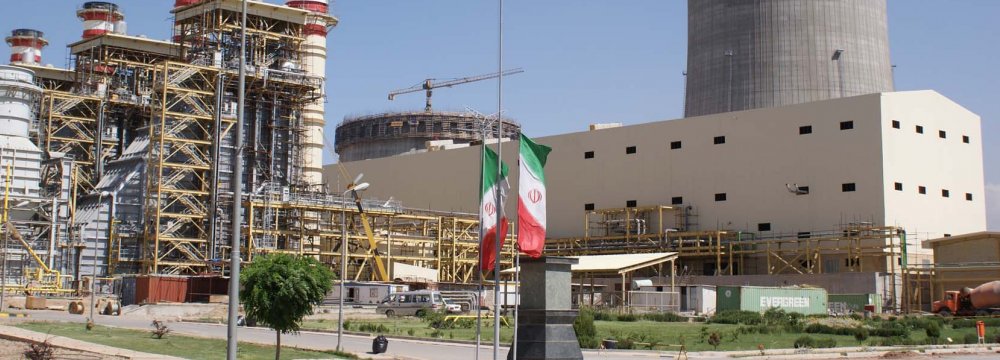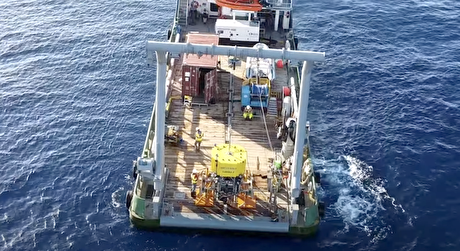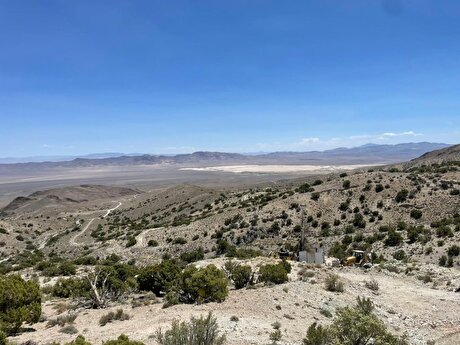
Installed Power Capacity Up 1% in Three Months

"Five new steam units and two gas units became operational in combined cycle power stations in the period," Mohsen Tarztalab was also quoted as saying by Mehr News Agency on Sunday.
The steam units were launched in Shirvan Power Plant in North Khorasan Province, Samangan Combined Cycle Power Plant in the southern Kerman Province, Parand Power Plant south of Tehran as well as Taban Combined Cycle Power Plant in Yazd Province.
According to Tarztalab, the project added a total capacity of 476 MW to the grid. The upgrade to combined cycle system will help save as much close to 1 billion cubic meters of natural gas as feedstock annually.
Pointing to Asalouyeh Power Plant in southern Iran, the TPPHC chief said, "Two-gas powered units with a capacity to generate 324 MW have recently become operational to provide the much-needed electricity to Damavand Petrochemical Company."
In the current fiscal year (started March 21), the company stepped up efforts to boost the efficiency of an unknown number of combined cycle powered plants from 35% to around 50%.
"The push will save over $170 million in [production] costs and curtail greenhouse gas emissions by 4 million tons a year," he said.
On the critical issue of meeting peak hour demand in the fiscal 2018-19, Tarztalab said plans are underway to construct 20 stations to add 3,252 MW of new power capacity to the national network by May 2018.
The official said power plants with a combined production capacity of 3,000 MW are dilapidated, which should be phased out.
"To do so, we have devised several plans, yet financial constraints impede the progress," he said.
Tarztalab stressed that every dilapidated power plant should be replaced with a modern one, otherwise the renovation plan will not come to fruition, with the initiative underway in Tehran and Sistan-Baluchestan provinces.
“Works on 160 MW of power capacity in the city of Zahedan and 1,034 MW in the capital Tehran have begun,” he added.
Massive Deficit
The disparity between real electricity prices, which include the costs for generation and transmission, and what subscribers pay, has caused the power industry to face a massive fiscal deficit amounting to roughly $1.5 billion a year.
Arash Kordi, the managing director of Iran Power Generation, Distribution and Transmission Company, made the statements on Saturday.
"Among more than 200 countries, Iran sells the cheapest power at an average price of 700 rials (about 2 cents) per kilowatt-hour," Kordi said, stressing that it is the lowest rate after India, Kuwait and China.
According to the official, in the country's neighboring states like Azerbaijan and Armenia, 1 kWh is being sold at 9 cents, making it roughly four times more expensive than that of Iran. "If electricity were sold at real prices, not only would the ministry not have to struggle in the face of mounting debts to the private sector, but it could also implement key development plans," he said.
Asked about power exchange with neighboring states, namely Iraq and Armenia, Kordi said Iran's electricity export at 9 billion kilowatt hours per year is three times more than its imports.


Gold price eases after Trump downplays clash with Fed chair Powell

Copper price hits new record as tariff deadline looms

Brazil producers look to halt pig iron output as US tariff threat crimps demand

Three workers rescued after 60 hours trapped in Canada mine

Gold price could hit $4,000 by year-end, says Fidelity

US targets mine waste to boost local critical minerals supply

Energy Fuels surges to 3-year high as it begins heavy rare earth production

Glencore workers brace for layoffs on looming Mount Isa shutdown

Chile’s 2025 vote puts mining sector’s future on the line

Kinross divests entire 12% stake in Yukon-focused White Gold

Gold price could hit $4,000 by year-end, says Fidelity

Southern Copper expects turmoil from US-China trade war to hit copper

Ramaco Resources secures five year permit for Brook rare earth mine in Wyoming

Column: EU’s pledge for $250 billion of US energy imports is delusional

Finland reclaims mining crown as Canada loses ground

Gold price down 1% on strong US economic data

Trump’s deep-sea mining push defies treaties, stirs alarm

Chile’s 2025 vote puts mining sector’s future on the line

Gold price retreats to near 3-week low on US-EU trade deal

Gold price could hit $4,000 by year-end, says Fidelity

Southern Copper expects turmoil from US-China trade war to hit copper

Ramaco Resources secures five year permit for Brook rare earth mine in Wyoming

Column: EU’s pledge for $250 billion of US energy imports is delusional

Gold price down 1% on strong US economic data

Trump’s deep-sea mining push defies treaties, stirs alarm

Chile’s 2025 vote puts mining sector’s future on the line

Gold price retreats to near 3-week low on US-EU trade deal

China’s lithium markets gripped by possible supply disruptions














